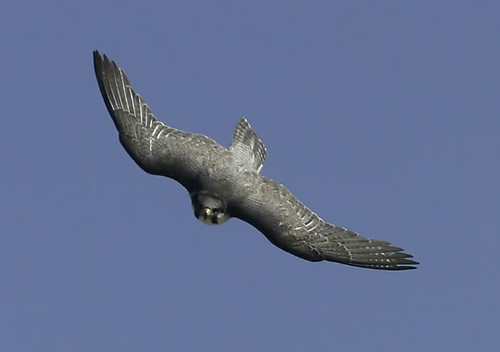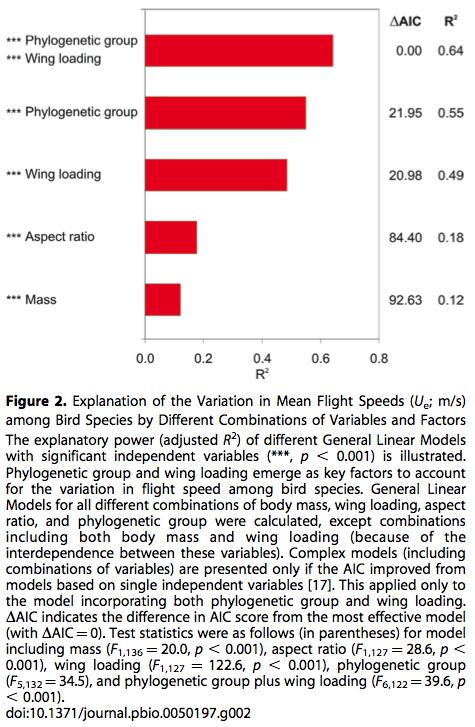tags: researchblogging.org, flight speed, birds, ornithology, aerodynamics, evolution
Not Bad, But Not Perfect
A peregrine falcon keeps a close eye as she circles her nest in St. Louis.
A new survey of 138 species of birds finds that closely-related birds fly at roughly the same speeds and that no birds are perfect flying specimens.
Image: Tom Gannam (AP) [larger]
When it comes to flight speeds, human-made contraptions, such as airplanes, conform to basic aerodynamic scaling rules, which generate predictions based on how much an object weighs and how large its wings are. However, those amazing creatures of flight, the birds, break these rules by flying faster or slower than predicted. How do they do this?
Using radar data, animal ecologists Thomas Alerstam and Mikael Rosen at Lund University in Sweden and their colleagues collected flight speeds for 138 species of birds during migration (approximately one-third of all European bird species), ranging from songbirds weighing less than one ounce to 20-pound swans. In theory, these birds' flight speeds should be a simple interaction between body mass and wing loading, so the authors analyzed these factors to determine which had the greatest influence over avian flight speed.
The researchers found that, surprisingly, mass had only a very small effect. Wing loading, on the other hand, had a larger influence over flight speed, but even then, it could not account for all the variation that the researchers found. In fact, they found that these two factors are more constrained for birds than pure theory allows, they report.
"Flight speeds among bird species scaled significantly differently with mass and wing loading than predicted from basic aerodynamic principles," reported Alerstam and his co-authors in their paper that was published in the recent issue of PLoS Biology.
So what accounted for this unexplained deviation from theoretical predictions? Fine-scale analyses revealed that evolutionary relatedness accounts for nearly 70 percent of the variation in flight speed, rather than aerodynamics (Figure 2).
"Phylogenetic group contributed in a highly significant way to explain the considerable variation in bird flight speeds that remained, even after the biometrical dimensions of the bird species had been taken into account," Alerstam reported.
The authors argue that the specific purpose of flight (such as hunting vs. travel) and style of flight (constant flapping vs. interspersed glides) as two potential influences. For example, birds of prey and herons flew more slowly than predicted, given their mass and wing loading, whereas songbirds and shorebirds was faster than predicted.
Large birds may fly slower than expected because high speed can prove inconvenient, "especially during takeoff, maneuvering and landing," Alerstam explained.
This study suggests that flight speed doesn't just depend on the size of the bird (mass and wing loading), but also reflects functional constraints and the evolutionary lineage of each species such that there exists a diversity of cruising flight characteristics among birds that remain to be explored. Understanding these hidden differences and the evolutionary forces behind them "could inform engineers on what special kinds of flight are needed for aircraft for special purposes, such as small flying robots carrying surveillance cameras into dangerous zones," Alerstam said.
Sources
Alerstam, T., Rosén, M., Bäckman, J., Ericson, P.G., Hellgren, O. (2007). Flight Speeds among Bird Species: Allometric and Phylogenetic Effects. PLoS Biology, 5(8), e197 | doi:10.1371/journal.pbio.0050197 [doi:10.1371/journal.pbio.0050197 [free PDF]. (figure)
YahooNews (quote)
DiscoveryNews (quote, image)
- Log in to post comments



The 'basic aerodynamic principles' used were developed for smooth-surfaced relatively inflexible wings used by traditional aircraft. I don't think there is a great deal of confidence among aerodynamic engineers that they 'work' for the various sorts of animal wings. For example, a Boeing engineer once used the fact that these same aerodynamic principles predict bumblebees should be unable to fly as an example of how limited these aerodynamic principles really are.
Thanks for providing more detailed on the paper than I gave: I'll have to rad it properly now. Of course, I did point out the big flaw in the paper.
Bob
In case you didn't know, this should be really interesting: The flight of peregrine falcons is based on the shape of a logarithmic spiral, which is itself based on phi, the golden ratio:
"Peregrine falcons (as the one shown in the picture above) are some of the fastest birds on Earth, plummeting toward their targets at speeds of up to two hundred miles an hour. But they could fly even faster if they would just fly straight instead of following a spiral trajectory to their victims. Biologist Vance A. Tucker of Duke University in North Carolina wondered for years why peregrines don't take the shortest distance to their prey. He then realized that because falcons' eyes are on either side of their heads, to take advantage of their razor-sharp vision, they must cock their heads 40 degrees to one side or the other. Tucker found in wind-tunnel experiments that such a head tip would slow them considerably. The results of this research, which were published in the November 2000 issue of the Journal of Experimental Biology, show that falcons keep their head straight and follow a logarithmic spiral. Because of the spiral's equiangular property, this path allow them to keep their target in view while maximizing speeds."
That's quoted from Mario Livio's "The Golden Ratio" (page 120).
what is the spped of this bird cause i am doing a project for school
what is slower than an eagle?